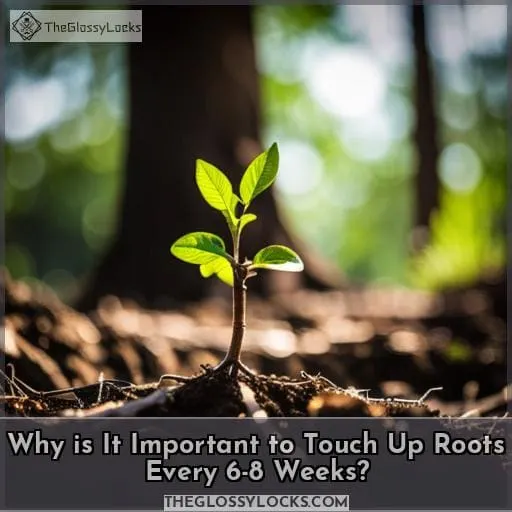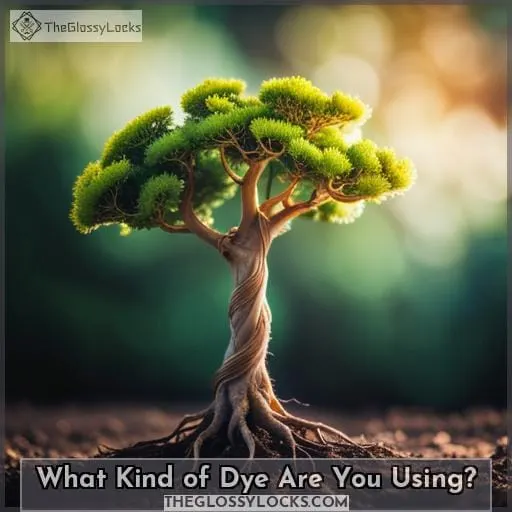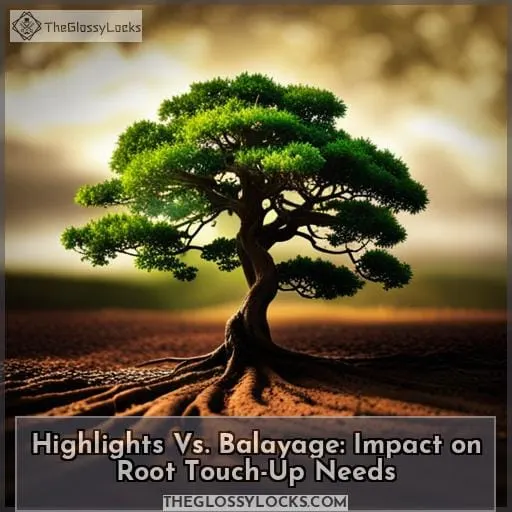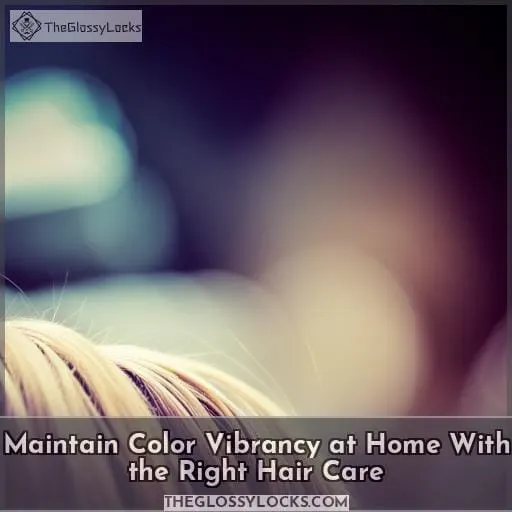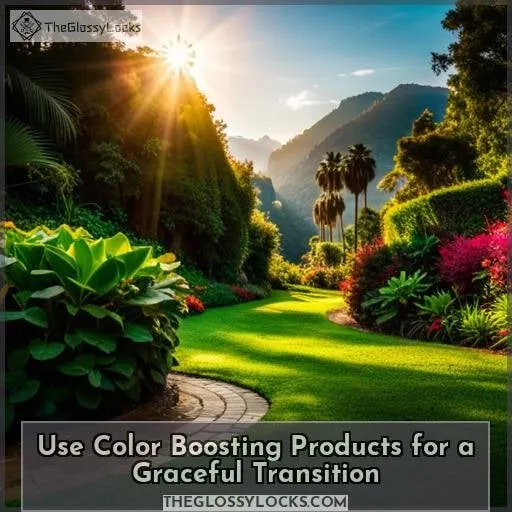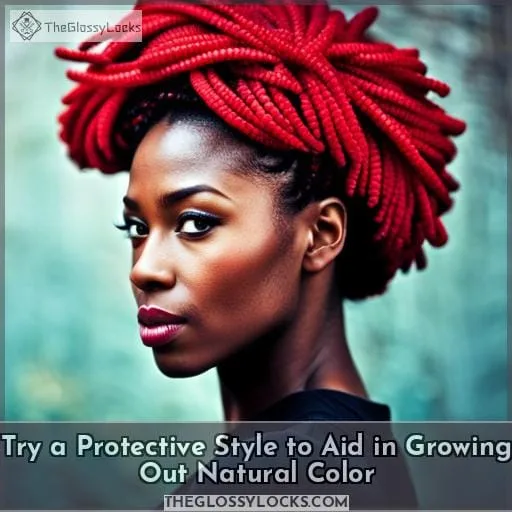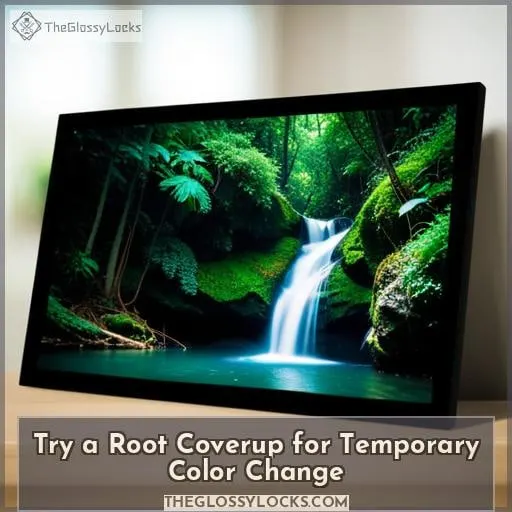This site is supported by our readers. We may earn a commission, at no cost to you, if you purchase through links.
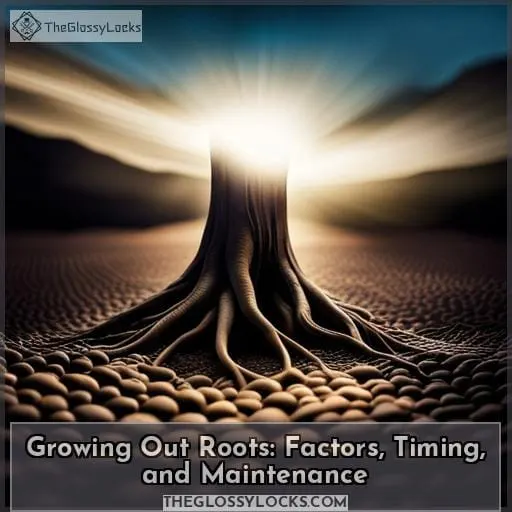 Are you looking to transition back to your natural hair color but don’t know how long it will take for roots to grow out? Growing out your roots doesn’t have to be a daunting task. It can be an enjoyable journey if you understand the factors and timing involved in transitioning back.
Are you looking to transition back to your natural hair color but don’t know how long it will take for roots to grow out? Growing out your roots doesn’t have to be a daunting task. It can be an enjoyable journey if you understand the factors and timing involved in transitioning back.
With the right products, techniques, and maintenance plan, you can keep your regrowth healthy while embracing a graceful transition from one hue into another over time.
So how long does it take for roots to grow out? Let’s explore the factors that affect hair growth rate as well as tips on maintaining vibrant coloring during this process.
Table Of Contents
- Key Takeaways
- How Long Does It Take for Roots to Grow Out?
- Why is It Important to Touch Up Roots Every 6-8 Weeks?
- What Kind of Dye Are You Using?
- Highlights Vs. Balayage: Impact on Root Touch-Up Needs
- Maintain Color Vibrancy at Home With the Right Hair Care
- Get Regular Trims to Aid in Growing Out Natural Color
- Use Color Boosting Products for a Graceful Transition
- Try Ombre or Balayage for a Smooth Transition
- Try a Protective Style to Aid in Growing Out Natural Color
- Try a Root Coverup for Temporary Color Change
- Conclusion
Key Takeaways
- Different hair types have different growth rates.
- Roots typically grow at a rate of 1-2 inches every 2-4 months.
- Hair growth rates vary based on factors such as season, hair type, and dye type.
- Heat, genetics, and seasons affect hair growth rate.
How Long Does It Take for Roots to Grow Out?

Understanding the rate of hair growth is important when growing out your natural color. Factors like heat, genetics, and seasons can affect the speed at which roots grow; however, on average, it usually takes between 2-4 months for 1-2 inches of root growth.
Different types of hair also have different rates, with straight fine hair typically growing faster than curly thick locks, while wintertime generally sees slower growth compared to warmer times.
Factors Affecting Hair Growth Rate
Your hair growth rate is impacted by scalp heat, dye type, and highlight frequency. Understanding these factors helps transition from dyed to natural color. Average Growth Rate, Seasonal Variations, Hair Types, and Growth Factors all affect the process.
Average Hair Growth Rate
On average, your hair can sprout up to a half-inch per month, like a flower in bloom. Hair growth rate varies by season, hair type, and dye types used. To keep roots looking seamless and maintain color vibrancy, regular root touch-ups are important.
Semi-permanent dyes require more frequent touch-ups than permanent ones for long-lasting results.
Hair Growth During Different Seasons
Experience the natural cycle of your hair growth as you transition to its original color throughout the changing seasons. In winter, hair grows at a slower rate and can take up to 12-14 weeks for one inch of root regrowth.
Summer months tend to bring faster growth, with roots growing in 6-8 weeks or less. Seasonal changes also affect demarcation lines between dyed and natural colors, which may require more frequent touch-ups during warmer months compared to cooler temperatures when transitioning out from dyeing your hair back to its original color.
Hair Growth Rate for Different Hair Types
The rate at which your roots grow out can differ depending on the type of hair you have; for example, curly hair typically grows faster than straight or wavy. Hair growth rates may also vary with seasonal changes and regular maintenance, such as root touch-ups.
Factors to consider are color consistency, root touch-up frequency, and embracing dark roots when transitioning back to natural color.
Why is It Important to Touch Up Roots Every 6-8 Weeks?
Maintaining consistency in hair color, avoiding noticeable regrowth, and preventing inconsistent color application are all important factors when it comes to touch-up intervals. Touching up roots every 6-8 weeks is key to enhancing overall hair appearance and ensuring the vibrancy of your dye job lasts longer.
Maintaining Consistency in Hair Color
To maintain consistent color, it’s important to touch up roots every 6-8 weeks. Root growth factors, like scalp heat and dye type, can affect the need for frequent touch-ups. Color vibrancy is maintained using products designed specifically for colored hair and root cover-up solutions.
Highlights require more regular maintenance, while balayage highlights typically don’t need touching up as often. Regular trims also help keep the transition from dyed to natural hair color graceful and smooth, while lower maintenance options such as tinting or glossing provide a long-lasting result with less upkeep needed between appointments.
Avoiding Noticeable Regrowth
You want to avoid visible regrowth, so it’s important to touch up your roots every 6-8 weeks. Hair types and seasonal effects impact the transition duration. A colorist can help with the maintenance of natural hair color or highlights; a color remover may be needed for quick removal.
Regular trims and root coverage solutions can also prevent noticeable regrowth while transitioning back to natural hues.
Preventing Inconsistent Color Application
Regular touch-ups every 6-8 weeks can help keep your color application consistent and avoid any noticeable regrowth – shocking to some, a single inch of root growth can take up to two months! Color-boosting products like The Good Stuff Color Protect Milk and Love Beauty Planet should be used between touch-ups.
Additionally, protective styles like braids or wigs provide an effective transition strategy for bleached hair. To maintain vibrant color vibrancy and healthy hair, use glossing treatments, regular trims, and deep conditioning treatments.
Enhancing Overall Hair Appearance
By incorporating protective styles, color-boosting products, and regular trims into your hair care routine, you can help ensure that your natural hair grows out gracefully while enhancing the overall appearance.
Color-safe shampoo and conditioner, along with semi-permanent dye, should be used to preserve vibrancy between touch-ups. Professional advice can aid in transitioning hairstyles for optimal coverage as well as provide instant changes when needed.
What Kind of Dye Are You Using?
Choosing the right type of hair dye is essential for maintaining healthy and vibrant color. Permanent dye typically requires touch-ups every 6 to 8 weeks, while semi-permanent dyes may require more frequent touch-ups due to their shorter lifespan.
Understanding the differences between these two types of dyes can help ensure your hair looks great and remains healthy over time.
Permanent Dye Vs. Semi-Permanent Dye
Comparing permanent and semi-permanent dye, the former can last up to three times longer than the latter, with an average of six weeks for touch-ups. Permanent hair color has a stronger effect on your roots as it is designed to penetrate deep into the cortex.
Semi-permanent dye coats strands instead, which means faster fading and more frequent root touch-ups are needed.
Frequency of Touch-Ups With Different Dye Types
Depending on the type of dye you use, touch-ups may require more or less frequent appointments. Semi-permanent dyes need to be touched up every 6-8 weeks, whereas balayage highlights typically don’t require any root touch-ups.
Hair growth factors also play a role in how often your hair needs to be colored. Regular trims can help maintain fresh color vibrancy. Color-safe products and protective styles, such as braids, are recommended for better overall hair health during transition periods.
By regularly trimming damaged ends, transitioning out dyed locks is made easier with minimal damage done to the hair due to chemical treatments used over time.
Effects of Different Dye Types on Hair Health
Considering the type of dye you use can have a direct effect on your hair health. Permanent dyes contain harsh chemicals that may cause damage and dryness, whereas semi-permanent ones are more gentle and fade away over time.
Look for color treatments that nourish the strands with natural ingredients like coconut oil or avocado oil. Pay attention to how often you need touch-ups – permanent dye requires frequent applications while semi-permanent only needs them every few months.
Highlights Vs. Balayage: Impact on Root Touch-Up Needs
Are you considering highlights or balayage for your hair? Knowing the touch-up needs of each is essential. Maintaining highlights near the scalp requires consistent root touch-ups every 6 to 8 weeks, while minimal touching up is needed with balayage since it creates a more naturally blended look.
Balayage can also be used as a transitioning technique when growing out natural color.
Maintaining Highlights Near the Scalp
When maintaining highlights near the scalp, it’s important to follow a 6-8 week root touch-up interval. Invest in color-protective products, use root concealer and colored dry shampoo between appointments, boost vibrancy with treatments such as glossing or tinting, and utilize protective hairstyles like braids or wigs.
Additionally, consider balayage for low maintenance care; regular highlighting should adhere to the guidelines mentioned earlier.
Minimal Touch-Ups With Balayage Highlights
Balayage highlights often require minimal touch-ups, so you can enjoy vibrant color for longer! Root concealer products help extend the time between regular touch-up intervals. Some benefits of balayage include cost savings and less time needed for natural hair transition.
For those looking to grow out their natural color, balayage is a great option with fewer root maintenance needs than traditional highlighting techniques.
Balayage as a Transitioning Technique
For transitioning to your natural hair color, balayage is a great option that helps you avoid frequent touch-ups. Benefits include: fewer maintenance visits, long-lasting highlights, and a low risk of inconsistencies.
Balayage vs. Highlights: the former requires minimal upkeep while the latter should adhere to 6-8 week root touch-up intervals for best results.
Maintain Color Vibrancy at Home With the Right Hair Care
Maintaining vibrant hair color at home requires the right hair care products. To keep your colored locks looking fresh and bright, opt for color-safe shampoos and conditioners like The Good Stuff Color Protect Milk or Love Beauty and Planet.
Root concealer and colored dry shampoo can also be used between touch-ups to extend the life of your dye job; brands such as TRESemmé or Dove offer effective root coverage solutions.
Importance of Color-Safe Hair Care Products
To ensure your color stays vibrant and healthy between root touch-ups, it’s essential to use color-safe hair care products. But how do you know which ones are best? Products like The Good Stuff Color Protect Milk and Love Beauty & Planet offer the benefits of protecting your color from fading while still nourishing strands.
Hair care essentials such as sulfate-free shampoo, conditioner, leave-in treatments, or masks can provide additional protection against damage that leads to dullness or brittleness over time.
Recommended Products for Color Protection
From protecting your roots to keeping color vibrancy alive, The Good Stuff Color Protect Milk and Love Beauty and Planet are top picks. TRESemmé’s root concealer is ideal for in-between touch-ups, while Dove offers great coverage solutions.
Using Root Concealer and Colored Dry Shampoo
Try using root concealer and colored dry shampoo to keep your color vibrant between touch-ups! Root concealers offer a temporary solution with many benefits, like coverage for gray roots, texture control, and easy application.
Colored dry shampoos, on the other hand, add a tint of color while absorbing dirt and oil from the scalp.
The differences between these two products should be considered when selecting one over the other. Concealer is more long-lasting than shampoo but also requires more effort in blending it into existing hair colors.
Effective Brands for Root Coverage Solutions
Discover the best root coverage solutions for at-home hair maintenance with brands like TRESemmé and Dove. Their products cover grays up to 80% more effectively, instantly concealing roots between touch-ups.
Temporary concealers come in various forms—from sprays to powders—for a natural look that lasts until your next appointment.
Get Regular Trims to Aid in Growing Out Natural Color
Regular trims while transitioning from dyed to natural hair color can be beneficial. Not only does it promote healthy hair growth, but a layered cut can also help speed up the transition process. With regular trims, you are able to maintain your desired style and keep your look fresh for longer periods of time.
Benefits of Regular Trims During the Transition
Regular trims can help you stay ahead of the game during your transition to natural color, so you can enjoy a vibrant and healthy look. Trimming regularly helps reduce split ends, which cause hair breakage, and improves volume and texture for a sleek finish.
Layered cuts are also beneficial as they allow for more versatility in styling while helping to speed up the transition process. Color-boosting products like glosses or toners give extra shine and vibrancy between touch-ups too! Regular trims, coupled with good hair care, keep your locks looking great throughout this transformation journey.
Speeding Up the Transition With Layered Cuts
Adding layers to your style can help accelerate the natural hair transition process – with each snip shaving off precious time! Layered cuts give you more styling options and allow for texture variation.
Plus, they reduce the amount of volume in thicker strands while adding movement to finer strands. Trimming away split ends also helps maintain healthy locks as they grow out and prevents breakage from occurring further down the shaft.
Promoting Healthy Hair Growth With Regular Trims
By getting regular trims, you can help maintain the health of your hair and support its natural growth as it transitions to its original color. Layered cuts are also a great way to speed up this process while keeping your hair looking stylish.
Color-boosting products provide an extra boost of vibrancy during the transition, while protective styles like braids promote healthy hair growth too.
Regular trims and layered cuts will ensure that growing out natural color remains a positive experience for all involved.
Use Color Boosting Products for a Graceful Transition
Enhancing your natural color and transitioning from dyed hair to a more natural hue is possible with the help of color-boosting products. The Good Stuff Color Protect Milk, Love Beauty and Planet, TRESemmé root coverage solutions, and Dove colored dry shampoo are some of the recommended products for boosting your existing shade.
This not only helps maintain vibrancy but also provides numerous benefits during the transition, such as cost-effectiveness and low maintenance compared to frequent dyeing.
Enhancing Color Vibrancy With Color-Boosting Products
To maintain vibrant color in between root touch-ups, try using color-safe hair care products like The Good Stuff Color Protect Milk and Love Beauty and Planet. Root concealer and colored dry shampoo are also great for a quick fix. Transition strategies such as protective styles, balayage highlights, or temporary colors can help you until your next salon appointment.
Recommended Products for Boosting Natural Color
Try color-safe hair care products like The Good Stuff Color Protect Milk and Love Beauty and Planet to boost your natural color. Root concealer can also be used in between touch-ups, with brands such as TRESemmé or Dove offering effective coverage solutions.
Hair growth factors, including scalp heat, can affect the rate of root transition, while protective styles like braids or wigs may help speed up the process.
Benefits of Color Boosting Products During Transition
Using color boosting products during your transition to natural hair color can help you achieve an effortless and graceful look with minimal maintenance.
- Improved root coverage solutions
- Hair growth factors that reduce transition time
- Protective style options for mixed gray roots or other hairstyles
Whether exploring balayage, ombre, highlights, or colored dry shampoo to cover grays, these strategies support a smooth and healthy journey back to your natural hue while maintaining vibrant coloring in-between touch-ups!
Try Ombre or Balayage for a Smooth Transition
If you’re looking to transition from dyed hair back to your natural color, ombre and balayage techniques can provide the perfect solution. Ombre offers a gradual lightening of your ends, while balayage allows for more personalized highlights that help blend in roots for an effortless look.
These methods are less damaging than traditional highlighting, requiring fewer touch-ups as well as allowing you to retain healthy length during the process.
Ombre as a Transition Technique
Embrace an ombre look as you transition to your natural hair color for a smooth, gradual change. Opt for ombre or balayage highlights instead of traditional coloring techniques to help blend in the roots and make the process easier on your hair.
Protective styles like braids and wigs can also be beneficial during this period. They help preserve existing color while allowing natural growth at the same time.
To keep your strands looking vibrant until it’s time for a root touch up or full dye job again, use color-boosting products such as The Good Stuff Color Protect Milk and Love Beauty and Planet.
If you’re in need of something quicker, there are instant color changing options available.
Balayage as a Transition Technique
Switching to balayage highlights can help make the transition from dyed to natural hair color a gentle breeze. Its advantages include enhancing and emphasizing your features without complete coverage, reduced maintenance with less frequent touch-ups, increased scalp protection allowing for healthier hair growth, and improved color consistency throughout the process.
Its benefits are numerous as it helps maintain protective styles while coloring, adds dimension and depth, increases shine and movement in your locks – all of which allow you to look fabulous even during this transition!
With its low commitment yet high impact results on both aesthetic appeal and health of our tresses, balayage is an excellent choice when growing out our natural hair colors.
Benefits of Ombre and Balayage During Transition
Experimenting with ombre and balayage techniques can bring a seamless transition to your natural hair color, while also providing long-lasting benefits.
Ombre is great for protecting the scalp from heat damage, and root touch-up intervals are longer due to less maintenance needed.
Balayage highlights typically don’t require any upkeep, allowing you to rock any style without the hassle of regular coloring or roots showing through.
Protective styles like braids or wigs help blend in grown-out roots with dyed ends, as well as adding a fashionable edge during this time of change.
Root concealer products provide quick fixes until the transition is complete and allow you to express yourself without needing frequent salon visits!
Try a Protective Style to Aid in Growing Out Natural Color
Protective styles are an excellent way to aid in the process of growing out your natural hair color. Not only can they keep your hair healthy during the transition, but there are many styling options available, such as braids and wigs.
Benefits of Protective Styles During Transition
Slipping into a protective style can be the secret to keeping your hair color looking fresh while you grow out your natural hue. Braids, wigs, and transition trims are all beneficial for avoiding gray or dark roots during this process.
Protective styles keep up with root growth so that when it’s time to go back to your original hue, there won’t be any delays in the process due to regrowth of color-treated strands.
Options for Protective Styles
Exploring different protective styles during your transition can help speed up the process of growing out natural color, with some hairstyles taking as little as 4 weeks! Consider braid options for a low-maintenance look or wig styles to cover gray roots.
Protective braids are also great for achieving temporary color while letting your natural hair grow in. For those looking to embrace their grays, consider stylish cuts and updos that flaunt them naturally.
Protecting Hair Health During the Transition
To ensure a smooth transition, give your hair the TLC it deserves by regularly trimming and deep conditioning. Protective styles like braids and wigs offer an effective way to shield from sun damage while transitioning to natural color.
Keeping colored dry shampoo, root concealer, and color-safe products on hand are also key haircare tips for maintaining vibrancy between touch-ups.
For those in a hurry for instant changes, professional dyeing, removers, or haircuts can expedite the process of reverting back to natural hair colors, including gray hair options! With patience comes beautiful results – explore protective style options that make you feel confident during this exciting transition duration!
Try a Root Coverup for Temporary Color Change
You can instantly upgrade your look by using a root coverup, helping you transition into the natural color of your hair in no time! Root concealers and colored dry shampoos are some examples of temporary color solutions that allow for an instant transformation.
These types of products often blend seamlessly with existing highlights or balayage styles while concealing any strands that have reached their touch up interval. If you’re looking for something more permanent, professional dyeing services may be needed to achieve desired results quickly but will require upkeep over time depending on the type used.
Consider all these root coverup options before deciding which is best suited for you – it could save both money and time!
Conclusion
Incredibly, growing out your roots doesn’t have to be a long, arduous journey. By understanding the factors that affect hair growth, you can develop a plan that allows you to transition gracefully and maintain your natural hair color.
Making sure to use color-safe hair care products, getting regular trims, and experimenting with ombre and balayage techniques can help you grow out your roots in as little as 2-4 months.
Additionally, protective styles, root concealer, and colored dry shampoo can be used to help you look your best while growing out your natural hair color.
With patience and the right strategy, you can have beautiful, healthy hair and make growing out your roots an enjoyable experience.

